|
|
|
Sort Order |
|
|
|
Items / Page
|
|
|
|
|
|
|
| Srl | Item |
| 1 |
ID:
088356
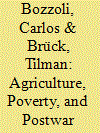

|
|
|
|
|
| Publication |
2009.
|
| Summary/Abstract |
This article analyzes the effects of household-level activity choices on farm household welfare in a developing country affected by mass violent armed conflict. The study uses household survey data from postwar Nampula and Cabo Delgado provinces in Northern Mozambique capturing many activity choices, including market participation, risk and activity diversification, cotton adoption, and social exchange, as well as income-and consumption-based measures of welfare. The study advances the literature on postwar coping and rural poverty at the micro level by estimating potentially endogenous activity choices and welfare outcomes using instrumental variables. The study finds that increasing the cultivated area and on-farm activities enhances postwar welfare of smallholders exploiting wartime survival techniques. Subsistence farming reduces income but does not affect consumption, while market participation has positive welfare effects. This suggests that postwar reconstruction policies should encourage the wartime crop mix but offer enhanced marketing opportunities for such crops. Cotton adoption, which was promoted by aid agencies in the postwar period, reduces household welfare per capita by between 16% and 31%, controlling for market access. This contradicts previous studies of postwar rural development that did not control for the war-related endogeneity. Hence, addressing the potential endogeneity of activity choices is important because the standard regression approach may lead to biased estimates of the impact of activity choice on welfare, which in turn may lead to biased policy advice. The article discusses and contextualizes these findings, concluding with a discussion of suitable pro-poor reconstruction policies for national governments and donors.
|
|
|
|
|
|
|
|
|
|
|
|
|
|
|
|
| 2 |
ID:
088357
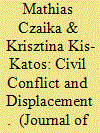

|
|
|
|
|
| Publication |
2009.
|
| Summary/Abstract |
The purpose of this article is to identify the determinants of displacement behavior based on various push and pull factors at the village level. The study concentrates on changes in village population during three years of civil conflict (1999-2002) in Aceh, Indonesia. The empirical analysis is based on a unique dataset from two census rounds of the Indonesian Village Potential Census (PODES). It uses data on around 5,200 Acehnese villages and relates village-level population change to conflict variables, geographic patterns, and traditional socio-economic determinants of migration. By applying quantile regressions, the push (outflow) factors and the pull (inflow) determinants of migration can also be distinguished. The authors identify the following factors as the main determinants of the Aceh migration pattern in this period. First, conflict clashes induced large rearrangements of the population between villages in highly affected districts, as well as strong village emigration from the geographically remote regions in Central Aceh towards the less conflict-affected coastal industrial areas. Besides conflict factors, an (ongoing) rural-urban migration process, driven by socio-economic factors, has taken place during the conflict period. Second, there is also evidence that security considerations, such as the presence of police in a village or neighborhood, were either emigration-reducing or immigration-inducing. Third, although the presence of ethnic Javanese has not been a primary cause of conflict incidence, their intimidation by the rebel movement has led to a significant outflow, primarily from conflict-affected villages in Central Aceh. These results reveal that, beside a conflict-induced fear of violence, population movements in Aceh have also been an outcome of traditional migration determinants.
|
|
|
|
|
|
|
|
|
|
|
|
|
|
|
|
| 3 |
ID:
088354


|
|
|
|
|
| Publication |
2009.
|
| Summary/Abstract |
The authors analyze a unique data source to study the determinants of violence against civilians in a civil war context. During the Vietnam War, the United States Department of Defense pioneered the use of quantitative analysis for operational purposes. The centerpiece of that effort was the Hamlet Evaluation System (HES), a monthly and quarterly rating of `the status of pacification at the hamlet and village level throughout the Republic of Vietnam'. Consistent with existing theoretical claims, the authors find that homicidal violence against civilians was a function of the level of territorial control exercised by the rival sides: Vietnamese insurgents relied on selective violence primarily where they enjoyed predominant, but not full, control; South Vietnamese government and US forces exercised indiscriminate violence primarily in the most rebel-dominated areas. Violence was less common in the most contested areas. The absence of spatial overlap between insurgent selective and incumbent indiscriminate violence, as well as the relative absence of violence from contested areas, demonstrates both the fundamental divergence between irregular and conventional war and the need for cautious use of violent events as indicators of conflict
|
|
|
|
|
|
|
|
|
|
|
|
|
|
|
|
| 4 |
ID:
088359
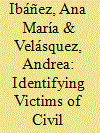

|
|
|
|
|
| Publication |
2009.
|
| Summary/Abstract |
Given that forced migration subjects households to extremely vulnerable conditions, the need to design particular policies for displaced populations is unquestionable. However, forced displacement poses several challenges to policymakers. In connection with low-intensity conflicts, such as in the case of Colombia, the main obstacle concerns the identification of households' victims of forced migration, so as to know to whom one should funnel aid. In such cases, inasmuch as victims migrate individually and tend to spread throughout a territory, identifying victims is difficult and channeling aid through supply-driven mechanisms is prohibitively expensive. To locate the households' victims of low intensity conflicts, an alternative - one adopted by the Colombia government - is to provide aid through demand-driven programs. This article evaluates whether demand-driven approaches aimed at assisting displaced households do in fact reach the entire displaced population. The study employs a survey applied to 1,553 households located in 48 Colombian municipalities. The authors identify to what extent a demand-driven approach excludes particular groups of households within the displaced population, examine what household characteristics determine the decision to declare one's eligibility for and final registration in RUPD, and analyze whether the exclusion of some groups of households is caused by the behavior of the relevant displaced households or by the deliberate targeting of these households by government offices. Results reveal that the exclusion of households from Colombia's RPUD program is mainly caused by lack of information regarding RUPD, with institutional determinants playing a lesser role.
|
|
|
|
|
|
|
|
|
|
|
|
|
|
|
|
| 5 |
ID:
088355


|
|
|
|
|
| Publication |
2009.
|
| Summary/Abstract |
This article examines the characteristics of the victims of the October 1993 massacres in Burundi. Using information on parents of the respondents of a 2002 demographic household survey, the author finds that the probability of a parent being killed during the events is significantly affected by age, sex and wealth, in the sense that older, wealthier and male persons were more likely to be killed. Using the median level of education of a parent's offspring to proxy the parental investment in human capital, the author finds that people who invested more in the human capital of their children ran a higher risk of being killed. The analysis also shows important spatial disparities in the killings. In trying to explain these locational effects, the author focus on two key hypotheses set forth with respect to the October 1993 events in Burundi: the land crisis and the questionable role played by the Front Démocratique du Burundi (FRODEBU), the dominant political actor at that time. The author finds that communal land pressure significantly increases the probability of being killed and that communal popular support for FRODEBU increases, in a non-linear fashion, the risk of being affected by the killings. The results are interpreted in light of the prevailing political economy of 1993 Burundi.
|
|
|
|
|
|
|
|
|
|
|
|
|
|
|
|
| 6 |
ID:
088353
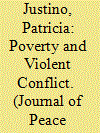

|
|
|
|
|
| Publication |
2009.
|
| Summary/Abstract |
This article discusses how endogenous mechanisms linking processes of violent conflict and the economic well-being of individuals and households in combat areas provide valuable micro foundations to the ongoing debate on the causes and duration of armed conflict. Notably, the endogenous relationship between conflict processes and household economic status leads to the emergence of symbiotic associations between armed groups and households living in areas they control that affect substantially the probability of a conflict starting and its effectiveness thereafter. Households in conflict areas draw on local armed groups to protect their economic status when anticipating violence and during the conflict, while armed groups make use of different levels of (either reluctant or voluntary) participation, support and cooperation from local populations to advance their strategic objectives at the onset and throughout the conflict. The level of household participation at the start and during the conflict is a function of two interdependent variables, namely household vulnerability to poverty and household vulnerability to violence. The poorer the household is at the start of the conflict, the higher is the probability of the household participating and supporting an armed group. The higher the risk of violence, the higher is the probability of the household participating and supporting armed groups. The interaction between these two variables varies with the conflict itself and is defined by the direct and indirect effects of conflict-induced violence on the economic behaviour and decisions of households in combat areas.
|
|
|
|
|
|
|
|
|
|
|
|
|
|
|
|
| 7 |
ID:
088358
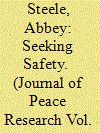

|
|
|
|
|
| Publication |
2009.
|
| Summary/Abstract |
Despite civil war violence, some civilians stay in their communities. Those who leave choose one of many possible destinations. Drawing on fieldwork in Colombia, this article argues that the way armed groups target civilians explains households' decisions about displacement. When groups of civilians are targeted based on a shared characteristic - `collective' targeting - their best options for avoiding violence differ from those targeted selectively or indiscriminately. This article outlines conditions under which people can stay in contexts of collective targeting, and where they are likely to go if these conditions are not met. A civilian facing collective targeting could move to a rival group's stronghold, cluster with others similarly targeted, or seek anonymity in a city or different region. Community characteristics, such as whether it is urban or rural, as well as macro characteristics of the war, such as whether or not there is an ascriptive cleavage, shape which decisions are relatively safest, which in turn leads to implications for aggregate patterns. For example, clustering together has a perverse effect: even though hiding among others with similar characteristics may reduce an individual's likelihood of suffering direct violence, the community may be more endangered as it is perceived to be affiliated with an armed group. This then leads to a cycle of collective targeting and displacement, which has important implications for the development of warfare. In turn, this cycle and related cleavage formation may have long-term impacts on postwar stability and politics.
|
|
|
|
|
|
|
|
|
|
|
|
|
|
|
|
|
|
|
|
|